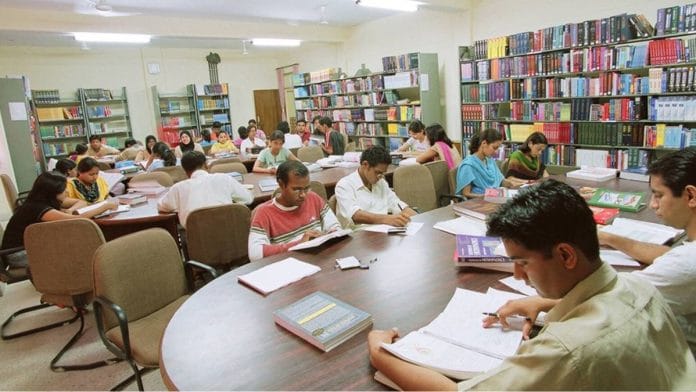New Delhi: The National Testing Agency (NTA) Thursday announced that the National Eligibility cum Entrance Test (Undergraduate) or NEET-UG will continue to be held in a pen-and-paper mode this year in a single-day and single-shift format.
The announcement is significant as it comes a month after the central government-appointed panel on exam reforms recommended various reforms, including transitioning to an online mode, and a multilevel NEET-UG.
The seven-member panel, led by Indian Space Research Organisation (ISRO) former chairman K. Radhakrishnan, was formed in June this year following allegations of irregularities in the National Eligibility cum Entrance Test (Undergraduate) or NEET-UG exam. The medical entrance exam was marred by allegations of paper leak and cheating, delaying the counselling process by nearly two months.
In a notification issued Thursday, the NTA said, “As decided by the National Medical Commission (NMC), it is informed that the NEET (UG)-2025 shall be conducted in Pen and Paper mode (OMR based) in Single day and Single Shift.”
According to senior officials in the ministry of education, the decision to go ahead with the pen-and-paper mode was taken by the NMC, which drafts the NEET-UG syllabus and also conducts counselling for admissions.
“The final decision was up to the NMC… the ministry does not take decisions for NEET-UG,” the official said.
‘Why the panel then?’
Several candidates raised concerns over the move, questioning the need for the Radhakrishnan committee in the first place when their recommendations would not be included. “Why did the committee take so many months to come up with recommendations when the intent was not to implement them?” asked Anchal Agarwal, a Class 12 student in Delhi.
Keshav Agarwal, a member of the Coaching Federation of India, felt the purpose of forming the committee was lost if its proposals were not heeded. “The lack of visible reforms has reignited concerns about the credibility of the examination system and the accountability of the authorities responsible for conducting it.” he said.
“For thousands of students who dedicate years of hard work in pursuit of their medical dreams, the absence of meaningful changes is both disappointing and disheartening. It is imperative that the NTA and concerned authorities take decisive steps to restore trust in the examination process and ensure a fair and secure system for all aspirants.”
Also read: NSDC joins hands with pollster Axis My India to map India’s skill gap. 1st report in 3 months
What Radhakrishnan committee said
The panel submitted the report to the Union education ministry last October and made several recommendations, including multi-session testing for large-scale exams, particularly when participant numbers exceeded two lakh.
It suggested that multistage testing be explored for NEET-UG.
It had also recommended a gradual transition from paper-and-pencil testing (PPT) to computer-based testing (CBT), while the associated challenges—especially in reaching underserved and remote areas—were resolved.
APAAR for transparency
Meanwhile, the NTA Tuesday advised candidates who apply for NEET-UG 2025 to use Automated Permanent Academic Account Registry (APAAR) ID for registration to enhance transparency, efficiency, and security.
In the official notice, the NTA urged candidates to use their APAAR ID as well as Aadhaar-based authentication during the application and examination process.
The Radhakrishnan panel had recommended implementing a “Digi Exam” system, similar to “Digi Yatra”, to ensure the candidate sitting for the exam is the same person who registered for it. This system will involve Aadhaar, biometric verification, and AI-based data analytics to authenticate the candidate’s identity at various stages of the exam process.
(Edited by Tikli Basu)
Also read: How UGC’s new rating system for higher institutions sets stage for flashpoint with non-NDA states







The sole concern of the Union govt is to ensure that students from the BIMARU states can qualify in record numbers and gain entry into prestigious medical schools across the nation. That was the objective which made the Union govt take up the responsibility for conducting the NEET entrance exams. The CBSE-PMT was working totally fine and there was absolutely no need for tweaking the system.
But the cow belt students were not able to get through during the CBSE-PMT days. Hence, the Union govt came up with this idea to help Hindi-speaking students crack the exam.
Also, the NEET-PG cutoffs have been lowered this year – again for the same reason.
The motives are quite easy to understand. The Centre wants the maximum number of successful candidates from the cow belt states. That is possible only if the test is conducted in such a way where it’s easy to indulge in unfair means.
All large scale cheating and scams in all-India entrance tests are carried out in the Hindi belt states.
One can even claim that this is what inspired the Central govt to take charge of medical entrance tests even though no state ever asked it to. The zealousness of the Centre to take up the responsibility of conducting entrance exams is to enable massive scale cheating in the Hindi states so that maximum students can qualify from these states.
Wow! Again aspirants from Bihar would crack the test in highest numbers.
The Union govt conducts most competitive entrance exams in a manner so as to suit the aspirants from the Hindi speaking belt. The objective is always to ensure that maximum candidates from this region are able to clear the entrance exam.
CBSE-PMT was working perfectly fine. Why did the Union govt feel the need for NEET-UG?